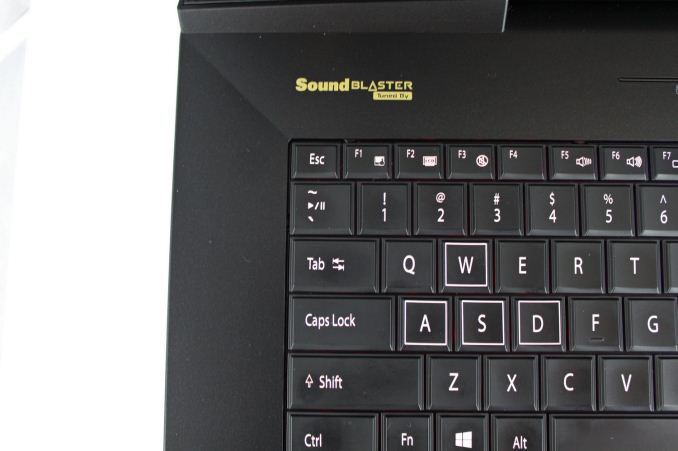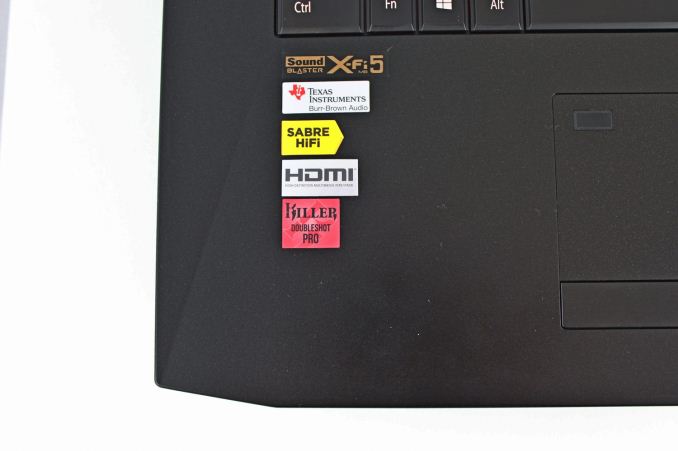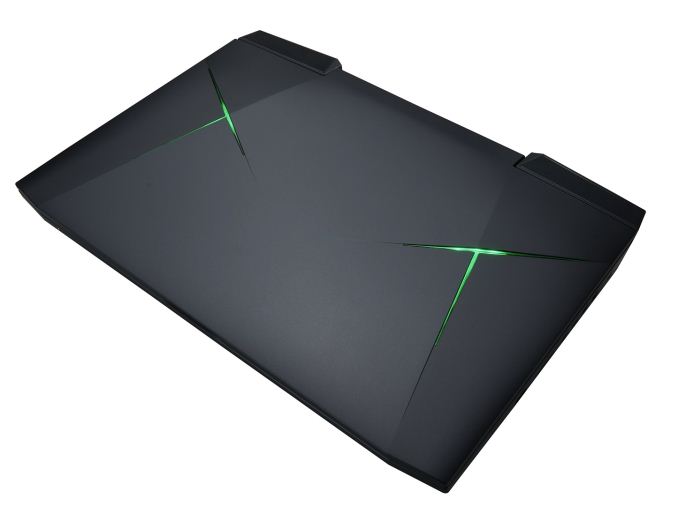The Clevo P870DM2 / Mythlogic Phobos 8716 Laptop Review: DTR With GTX 1080
by Brett Howse on October 27, 2016 2:00 PM ESTFinal Words
What else is there to say about this notebook? If you are after a desktop replacement, the market shrinks considerably, and very few companies offer desktop class processors in notebooks these days. Clevo is one of them, and they have shoehorned a full 91-Watt overclockable processor into this notebook. On CPU bound tasks, it is very likely that there is no other high volume notebook that is faster than this one. The performance is very impressive.
On the GPU side, there are plenty of options here too, but all of them based on the new Pascal architecture from NVIDIA. With just a 1920x1080 panel to push, even the GTX 1070 is going to have very good performance, but the GTX 1080 is such a big step up in the notebook market that it’s almost difficult to believe. It is basically twice as fast as the outgoing GTX 980M in real-world gaming tests. The GTX 980M was no slouch, but with NVIDIA moving to the full desktop class GPUs in notebooks this year, the jump in performance is as big as any seen in recent years. For those that really want the best of the best, Mythlogic offers this laptop with SLI GTX 1080 (or 1070), and choices of a 1920x1080 IPS 120 Hz display, 2560x1440 120 Hz G-Sync display, and 3840x2160 60 Hz G-Sync as well. The lower resolution display does have the advantage of being a 120 Hz display though, and the GTX 1080 can pretty easily drive most games at or above that refresh rate. The 2560x1440 seems like a great sweet spot for the non SLI models though, especially with G-Sync.
There are a lot of configurations available, which is typical of these types of systems, and it’s nice to be able to pick and choose your components a bit more than the larger OEMs allow. There is room for multiple M.2 SSDs, multiple 2.5-inch SSDs, and four SO-DIMM slots for memory. All of the components can be accessed through the bottom, or by removing the keyboard.
The chassis is far from the best around, with it being a large, thick, machine, made entirely of black plastic. The styling is ok though, with no crazy artwork or anything, and honestly for a notebook that is going to live its life on a desk, it is going to be absolutely fine.
What isn’t as fine is the keyboard. MSI has a fully mechanical keyboard in the GT83VR Titan, Razer has low profile mechanical switches in the new Razer Blade Pro, and Alienware has really worked hard at improving their keyboard as well with this generation. The Clevo keyboard feels like it is from about a decade ago, with very little travel despite the notebook being almost two inches thick. The keys themselves have very little bevel to them, and all of the keys are packed in so tight that it is very easy to lose where you are and hit the wrong key by mistake. If you are going to use this as a true desktop replacement, I suppose an external keyboard is an option, but it really shouldn’t need to be this way. The trackpad is just average, but here it’s difficult to be too critical since almost everyone that purchases a laptop like this is going to use it with a mouse.
At the end of the day, I am not the target market for this device. I have a desktop, and I haven’t moved houses in over a decade, but you can certainly see the appeal of having all the performance of a desktop in something you can move around a lot easier. Maybe you travel for work, or maybe you go to school, but being able to pick up a full desktop with the display attached and put it in a big is going to be a nice perk. And, even with all of these powerful components inside, the pricing is very reasonable. It’s hard to say something that starts at $2250 is inexpensive, but for what you get it is not. The base model still has a GTX 1070 and a desktop class 65-Watt CPU, and a 120 Hz display. You can tack on a lot of options to really drive up the price, but even this review unit with a GTX 1080, 32 GB of memory, and a Core i7-6700K still comes in under $3000. For that money, you won’t be able to find another laptop with this much performance available.













61 Comments
View All Comments
ZeDestructor - Thursday, October 27, 2016 - link
Picture of the innards clearly shows one MXM module populated with an empty slot for a second MXM module. With two MXM cards installed, the heatsink for each GPU is shrunk by half though (second card takes over the second fan and gimps the first card to only having the leftmost fan), so there will be a lower boost max.Glaurung - Thursday, October 27, 2016 - link
"Let's be real, you aren't moving this thing around. Just buy a desktop."A laptop takes up much less room than a desktop, and you can close the lid and stow it away in a drawer. Whereas a desktop is always going to be hogging space on your desk for its keyboard, mouse, and monitor. For someone with a small apartment or student dorm room, the ability to simply close the lid and stow the whole thing away is a huge benefit. Don't think of this as a battery powered portable computer, think of it as a compact, stowable computer that has a built in UPS.
andychow - Thursday, October 27, 2016 - link
While I agree with the statement that many buy laptops to be able to stow the thing away, this is a $2255-$5000 device. It's not something I would imagine people in small apartments or dorms would get. Then again, I see "poor" students with macbook pros all the time. You have a good point actually.nerd1 - Sunday, October 30, 2016 - link
Many students I know pay >70k for just tution and rent. $2500 laptop is not that expensive in that regard (especially compared to macbook pros with the same price range)Morawka - Thursday, October 27, 2016 - link
12 pounds for that model, its still a lot easier than lugging around a tower, monitor, cables, etc..this is a great mobile VR Rig.a
DanNeely - Thursday, October 27, 2016 - link
Do you have any power usage figures? I'm curious what the TDP for the mobile version of pascal is. A Desktop 1080 is 180W, did manage to knock 80W of the mobile card to match the outgoing 980m despite only dropping the clock rate a few percent (massive binning???), or is near desktop performance equivalence coming at a huge expansion in power consumption?BrokenCrayons - Thursday, October 27, 2016 - link
You can do some quick estimations based on the fact that the SLI version requires two 330W power supplies.Add to it the cooling configuration of six heat pipes and two radiators...but we need to go back a bit to older tech for the heat pipes. A Dell Latitude D630 with an Intel x3100 GPU has a single heat pipe for the chipset and 35W processor's cooling needs. Assuming the pipe design is better means that a single heat pipe can likely handle 45W total TDP and that's a pretty reasonable estimate, but let's be conservative and say one pipe can deal with only 30W TDP. 30 x 6 pretty much means 180W TDP for the mobile part. Take into account the GPU can't sustain a full load at its highest clock even with all that cooling capacity and I think we're looking at a mobile GPU with the same TDP as the desktop part. There's certainly a lot of compelling evidence pointing that way anyhow.
DanNeely - Thursday, October 27, 2016 - link
Full desktop power is certainly possible, but the need for a second power brick doesn't prove much beyond >~110W. 90 (CPU) + 30 (everything else) + 2x110 = 340W which would max out the 330W power brick.I don't think your handwaving with the heatpipe count argument holds any strength, the size of the heatsinks on the other end, the power of the fans, and what temperatures are considered acceptable puts too much variation to try and assign an N Watts capacity to a single pipe and scale off of that.
BrokenCrayons - Thursday, October 27, 2016 - link
It's all extremely rough estimation on my part and I admit readily it's rife with possible faulty thinking and off-the-cuff guesswork, but unless or until we get credible numbers either from NV directly or from a group equipped to perform accurate analytics, there's nothing left but idle speculation...which can be sort of fun in its own way even if it ends up being way off the mark.Brett Howse - Thursday, October 27, 2016 - link
Please don't forget that this also supports overclocking, so they have to supply a big enough power adapter to avoid running out of headroom when overclocking, so you can't really make the assumptions you are.NVIDIA doesn't have formal TDP numbers for the mobile parts, but they are going to be somewhere under the desktop ones.